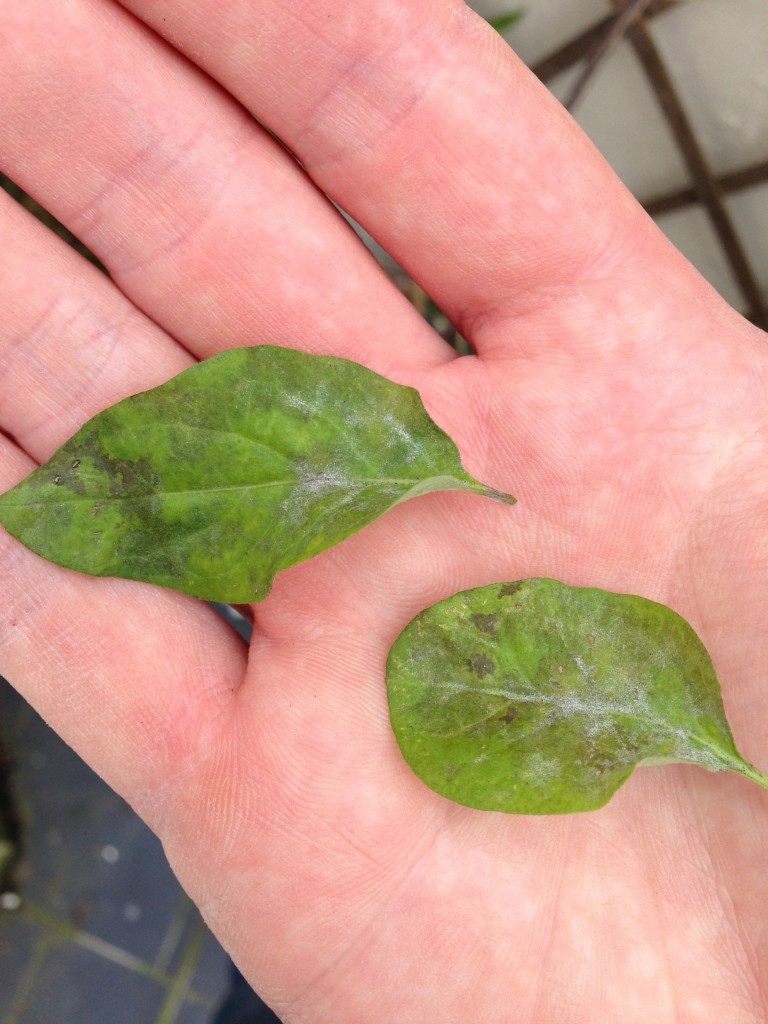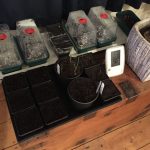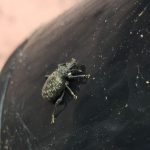 For every positive in the garden this summer there has been a pest or a disease to eat it. It’s been depressing.
For every positive in the garden this summer there has been a pest or a disease to eat it. It’s been depressing.
The antirrhinum developed rust early on, powdery mildew on the Lonicera, slugs and snails have been a constant pain, eating everything in sight, and in recent months vine weevils have been showing their faces at night all over our cyclamen and astilbes. Tonight, I think I spotted sclerotinia blight on the new Echinecea purpurea ‘Fatal Attraction’. Groan. Either that or it’s just more vine weevil in the flower bed. Double groan.
Rather foolishly, I thought our mini Clapham based garden in London would be near immune to pests and diseases but of course, it’s been the complete opposite. The warmer inner city climate, the vast majority of shipped in plants in the many gardens and the general lack of garden hygiene in the area, not to mention cats scaring off (or eating) all bug eating birds and toads appear to have created a melting pot of problems.
I am hoping that it’s also the result of the fact the garden hasn’t been patrolled for pests for a number of years, combined with the mild winter last year. So 2015 may see slightly fewer little bugs.
I’ve learnt a lot though, having faced all of these problems, especially as I have tried to be organic and wildlife friendly until pushed to a chemical based last resort. Here’s a list of what has and hasn’t worked:
Slugs and snails – our biggest pest problem in 2014
- Nematodes: very hard to know if these actually worked. I don’t think they did. I tried two applications both when the weather was perfect. The slugs and snails still overran the garden in their hundreds. Of course, nematodes don’t work at all on snails (our biggest infestation this year) because they don’t go below ground where the nematodes wriggle.
- Beer traps: worked well with expensive ales, did not work with cheap Sainsbury’s own brand. Surprisingly, beer traps worked much better than I expected. But I think for them to truly make an impact, you do need one every meter or so to allow the slugs and snails to smell it. In the early summer beer traps really helped to keep the population down. The resulting slime does stink a bit too, so you need to clear regularly.
- Manual spotting and dispatching: one of the best solutions I found was simply to go outside just after it has rained and hand pick off the little blighters myself. Especially for snails because they are more visible and can’t be dealt with using nematodes.
- Copper tape: definitely one of the foolproof methods that work. Around pots is easiest, you just stick it on and nothing gets across, but you have to keep an eye out for bridges made of leaves. In the plant beds, I cut out 3 inch deep rings of plastic from fizzy drinks bottles, then stuck copper tape around them and wrapped the ring around some plants to protect them, pushing the base of the plastic an inch or two into the soil so nothing could go under it. This did work very well. Even though the plants created bridges with their leaves, they received much less damage than those plants without because slugs and snails weren’t reaching the crowns. I would highly recommend this and will do again next year, particularly on young plants.
- Ferrous sulphate slug pellets: by the end of the summer, I snapped and went non-organic. I’d especially been resisting slug pellets because of our cat. Then I came across Ferrous sulphate based slug pellets that are apparently safer for pets as long as you are very careful to spread them out and avoid any kind of pile (enough to affect an animal). I also carefully placed ours only under the plants, to minimise risk to birds – though note, this isn’t totally safe as the slug or snail could easily move into the open. The result though? No slugs or snail damage whatsoever since I’ve used them. This is without a doubt the best cure for slugs and snails right now.
- Liquid slug poison: I used this too which worked but was difficult to cover meaningful areas of garden. It was useful though for climbing plants. I don’t think I’ll be using it now that I have found the relatively cat safe slug pellets however.
- Anti slug barrier products: I used one anti slug and snail barrier you can buy in a box. It kinda worked but not for long and formed a clay like sludge which grew algae all over it. I will avoid using. Coffee granules seemed to work as well, though is much less permanent – coffee granules did work a charm on preventing cat poo though!
Vine weevils
- Manual spotting and dispatching: a torch at night, gloves to pick them up and a stone to crunch them. It’s unpleasant but the only real way of getting rid of the adults.
- Nematodes: to be confirmed. I used one application of Nemasys Vine Weevil killer a couple of weeks ago and to be safe, I’m also going to use some from Defenders this week before the temperature drops. I’m not entirely convinced nematodes really work well in the garden without more careful application but I’ll give it a shot. My garden is so small that really, next year we should have very few if any vine weevils if these do work. I’ll let you all know.
- Provado Vine Weevil Killer: I have tried applying some vine weevil killer to some pots and some specific plants as well. Again, it’s hard to know if this has worked. The proof will be in the rather horrid buggy pudding next year. I would prefer not to use this poison if the nematodes do work. This poison is apparently one of the worst offenders for ground dwelling bees, so it really is a last resort and only to be used in select pots.
Antirrhinum rust
- Scotts fungus clear ultra concentrate: I used this in a concentrate form in a spray bottle and it worked a charm I have to say, and has to date lasted all of summer after one hefty drenching. I also cut back some of the worst affected plants. The rust vanished.
Fuchsia rust
- Scotts fungus clear ultra concentrate: one of my fuchsias to my dismay has developed a deep case of rust too. I have sprayed it with the same solution that worked on the antirrhinum but it doesn’t appear to have worked yet. To its credit though, I did leave the concentrate mixed in the bottle for over a month so may not be how it’s suppose to be used. I’ll try again this week.
- Removing leaves: I don’t know if this has worked yet but I’ve taken various sources’ advice to remove all infected leaves I can see, which has turned a beautiful plant into a bunch of sraggly twigs 🙁
Powdery mildew
- Binning plants: in some cases I just wanted the powdery mildew gone to prevent it spreading, so digging up and throwing away some plants into the bin stopped it right there.
- Removing leaves: I have two lonicera that have both developed powdery mildew. On both I removed badly infected leaves. This never seemed to halt the progress of the fungus and in one case appeared to make it worse as it weakened the plant – though I would still recommend you do remove infected leaves.
- Scotts fungus clear ultra concentrate: on the stronger of the plants, this seems to work for 6 – 8 week intervals, then it needs another application. On the weaker plant, it doesn’t seem to have worked. I think the plant is just struggling in general.
So, all in all, for such a small garden I’ve faced what is more than my unfair share of problems. I am hoping that next year things will be better because I’ve made a dent in some populations this year. Also because some plants that survive winter will be stronger and more established, thus more disease and pest resistant.
I’ll be gutted if the new Echinecea does have sclerotina, I love this particular plant and lots of advice is to just dig up and bin immediately. Fingers crossed…




Hi,
Always good to hear how others battle garden pests!
Having a Chimenea in the garden meant ash for the beds. This is also good as a slug n snail barrier.
If you start to brew your own beer you will have a good supply of slops for your beer traps. I also found this the best method in my garden.
Good tips and good blog!
Merlinsboy
aka Rhys
Thanks Rhys, I’ll be sure to pick up a Chimenea for next spring and give that a go. Funnily enough, in times gone by people must have used the beds for dumping old coal from the Victorian fire places – wherever I dig there’s ancient spent coals! Not quite as useful 😉